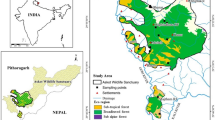Abstract
This study deals with the regeneration status of certain tree components of forests in the northwestern catchment of the river Gola in Kumaun Himalaya and explores possible compositional changes in time.Pinus roxburghii, Quercus floribunda andQuercus lanuginosa in their respective forest types had a stable population structure with a large percentage of young individuals (seedlings) and relatively few old ones, indicating that these species are frequent reproducers. The girth class distribution of the individuals ofQuercus leucotrichophora in theQuercus leucotrichophora forest suggests that this species is likely to disappear gradually. In this forest, although forest composition will remain unchanged for some time, a complete absence of seedlings of any species shows the possibility of its complete replacement by a scrub or a grassland vegetation. In the mixed forest, the dominant species, viz.,Quercus leucotrichophora, Persea odoratissima andBauhinia retusa did not have saplings/seedlings, indicating a possible change in forest composition in the near future whenSapium insigne, Cocculus laurifolius, Celtis eriocarpa andAcer oblongum are likely to gain dominance. Finally, suggestions are made to explain the poor regeneration ofQuercus leucotrichophora.
Similar content being viewed by others
References
Auclair, A. N. & Cottam, G., 1971. Dynamics of black cherry (Prunus serotina Ehhr.) in southern Wisconsin oak forests. Ecol. Monogr. 41: 153–177.
Austin, M. P., 1977. Use of ordination and other multivariate descriptive methods to study succession. Vegetatio 35: 165–175.
Benton, A. H. & WernerJr., W. E., 1976. Field Biology and Ecology. McGraw-Hill, New York. 564 pp.
Champion, H. G. & Seth, S. K., 1968. A revised survey of the forest types of India. Govt. India Publ., Delhi. 404 pp.
Dobremez, J. F., 1972. Carte écologique du Népal. II. Région Jiri-Thodung 1/50 000. Doc. Carte Vég. Alpes 10: 9–24.
Dobremez, J. F., 1973. Carte écologique du Népal au 1/250 000. IV. Région Terai Central. Documents de Cartographie écologique 12: 1–16.
Dobremez, J. F. & Jest, C., 1971. Carte écologique de la région Annapurna-Dhaulagiri. Doc. Carte Vég. Alpes 11: 1–49.
Dobremez, J. F., Maire, A. & Yon, B., 1975. Carte écologique du Népal. V. Région Ankhu Khola-Trisuli 1/50 000. Documents de Cartographie écologique 15: 1–20.
Dobremez, J. F. & Shakya, P. R., 1975. Carte écologique du Nepal. IV. Région Biratnagar-Kangchenjung à 1/250 000. Documents de Cartographie écologique 26: 33–48.
Dwivedi, B. N. & Mathur, R. S., 1978. Working plan for the Naini Tal Forest Division, Kumaun Circle, Uttar Pradesh, 1978–79 to 1987–88. Naini Tal Working Plans Circle, U.P. 521 pp.
Goff, F. G. & West, D. C., 1975. Canopy-understory interaction effects on forest population structure. Forest Sci. 21: 98–108.
Gupta, P. N., 1979. Afforestation, integrated watershed management, torrent control and land use development project for U.P. Himalayas and Siwaliks. U.P. Forest Dept. 58 pp.
Horn, H. S., 1976. Succession. In: R. M., May (ed.), Theoretical Ecology, pp. 187–190. W. B. Saunders, Philadelphia.
Kenoyer, L. A., 1921. Forest formations and succession of the Sattal Valley, Kumaun Himalayas. J. Indian Bot. Soc. 2: 236–256.
Knight, D. H., 1975. A phytosociological analysis of species-rich tropical forest on Barro Colorado Island, Panama. Ecol. Monogr. 45: 259–284.
Knuchel, H., 1953. Planning and control in the managed forest. Oliver and Boyd, Edinburgh. 360 pp.
Leak, W. B., 1973. Species and structure of a virgin northern hardwood stand in New Hampshire. USDA Forest Serv. Res. Note NE-181 4 pp.
Meyer, H. A., 1952. Structure, growth and drain in balanced unevenaged forests. J. For. 50: 85–92.
Meyer, H. A. & Stevenson, D. D., 1943. The structure and growth of virgin beech-birch-maple-hemlock forests in northern Pennsylvania J. Agric. Res. 67: 465–484.
Pandey, U. & Singh, J. S., 1981. A quantitative study of the forest floor, litter fall and nutrient return in an oak-conifer forest in Himalaya. I. Composition and dynamics of forest floor. Acta Oecologica (Oecol. Gener.) 2: 49–61.
Pandey, U & Singh, J. S., 1984. Energy flow relationships between agro- and forest ecosystems in Central Himalaya. Environ. Cons. 11: 15–23.
Puri, G. S., 1960. Indian Forest Ecology, I. Oxford Book and Stationary, New Delhi, 318 pp.
Raina, B. N. & Dungrakoti, B. D., 1975. Geology of the area between Naini Tal and Champawat, Kumaun Himalaya, Uttar Pradesh. In: A. G., Jhingran & P. K., Verma (eds.), Himalayan Geology, 5, pp. 1–27. Wadia Institute of Himalayan Geology, Delhi.
Ranney, J. W., 1978. Edges of forest islands: structure, composition, and importance to regional forest dynamics. Ph. D. diss., Graduate Program in Ecology, Univ. Tenn., Knoxville. 193 pp.
Saxena, A. K. & Singh, J. S., 1980. Analysis of forest-grazingland vegetation in parts of Kumaun Himalaya. Indian J. Range Manage 1: 13–32.
Saxena, A. K. & Singh, J. S., 1982a. A phytosociological analysis of woody species in forest communities of a part of Kumaun Himalaya. Vegetatio 50: 3–22.
Saxena, A. K. & Singh, J. S., 1982b. Quantitative profile structure of certain forests in the Kumaun Himalaya. Proc. Indian Acad. Sci. 91: 529–549.
Schmelz, D. A. & Lindsey, A A., 1965. Size-class structure of old-growth forests in Indiana. Forest Sci. 11: 258–264.
ShugartJr., H. H. & West, D. C., 1980. Forest succession models. Bioscience 30: 308–313.
Spurr, S. H. & Barnes, B. V., 1980. Forest Ecology. John Wiley, New York. 687 pp.
Steenis, C. G. G. J.van, 1958. Rejuvenation as a factor for judging the status of vegetation types: the biological nomad theory. In: Proc. Kandy Symp. Study of Tropical Vegetation, UNESCO, Paris. pp 159–163.
Steinbrenner, E. C., 1951. Effect of grazing on floristic composition and soil properties of farm woodlands in southern Wisconsin. J. For. 49: 906–910.
West, D. C., ShugartJr., H. H. & Ranney, J. W., 1981. Population structure of forest over a large area. Forest Sci 27: 701–710.
Author information
Authors and Affiliations
Additional information
Nomenclature: see Figure 3.
Financial support from the Indian Space Research Organisation, Bangalore, is gratefully acknowledged.
Rights and permissions
About this article
Cite this article
Saxena, A.K., Singh, J.S. Tree population structure of certain Himalayan forest associations and implications concerning their future composition. Vegetatio 58, 61–69 (1984). https://doi.org/10.1007/BF00044928
Accepted:
Published:
Issue Date:
DOI: https://doi.org/10.1007/BF00044928




